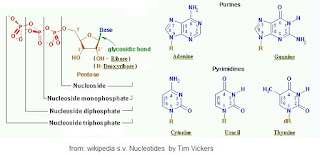Way back in January 2013, I did a post about the make-up of a part of the cell which produces energy, a set of proteins called ATP Synthase. The post is HERE, and it includes a little video about ATP Synthase which processes protons through a membrane due to an electrical gradient set up by yet other sets of proteins. I want to re-post a picture of this sequence from KEGG database called "oxidative phosphorylation" because it is amazing (sorry if my reproduction is a little fuzzy-- a direct link for this image data is HERE). Please note that all the different-colored parts are different proteins that have different genes:
However, I did not add everything I could have to that post to make the picture complete. I showed the amino acid sequence of one of the sub-unit proteins, but I'd like to take the composition of a Beta sub-unit one step further to show the human gene sequence. This is the darker blue piece of the protein set on the right of the above picture:
Each letter in the image above stands for a molecule called a nucleotide. These in turn are a code for producing the sequence of amino acids needed to make the protein subunit. In this case there are 1590 of the DNA nucleotides. These molecules, made of atoms, exist in the ladder-like DNA helix structure which sends a code through the cell to make proteins. There are 4 letters in the chart above --c, t, g and a. Below is a picture of them (the fifth, Uracil, is in RNA, a whole other story). The N stands for nitrogen, H for hydrogen, O for oxygen, and C, carbon, is understood in the corners of the "rings" that don't have letters). The R is where they attach to the rest of the DNA molecule:
Though perhaps every amino acid (coded by the DNA nucleotides) does not have to be exactly where it is in this Beta subunit, as in all proteins, many do. The protein has to have a structure that will hold together in a certain shape, and some amino acids do better on the outside of the protein and some on the inside. Then this Beta piece along with another type of protein provide the conformations that allow the chemical change of one molecule into another (ADP to ATP). The ATP is what gives energy to our metabolism and in fact is needed to produce more DNA and proteins. The machine-like quality of the ATP Synthase is due to several specific amino acids that can accomplish this task when the ATP Synthase complex turns on an axis. There is another way to produce ATP which I won't go into: substrate-level phosphorylation. This requires its own complex sets of proteins and you can always Google the name if you are interested in learning more.
Overall, you have a chicken and egg problem: DNA is needed to code for the proteins that make ATP which is needed to make DNA. Though many want to believe that life came through natural physical laws, we have to consider at least two events: first, beginning of life; second, continuation and change of life forms (evolution). At the beginning we have to understand that the chemistry that would affect the atoms of the atmosphere is under the Law of Mass Action (Wikipedia entry HERE), where atoms and molecules move randomly but collectively act in a certain way. Even quantum physics becomes random at the Newtonian level. Though some want to dream of finding physical laws that would put DNA together "naturally," in my opinion they are literally dreaming. They accuse Creationists of not being able to acknowledge that God could create through physical laws, but what about them acknowledging that He could create directly?
In the Bible, the Apostle Paul says that God made Creation in a way that it is obvious for us to see His eternal power and divine nature (cf. Romans 1:20 NABRE). I agree with Paul.
Thursday, September 20, 2018
Subscribe to:
Post Comments (Atom)








No comments:
Post a Comment
Comments are moderated. You do not have to agree, but please be civil. Thanks for your interest.